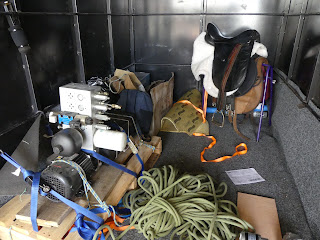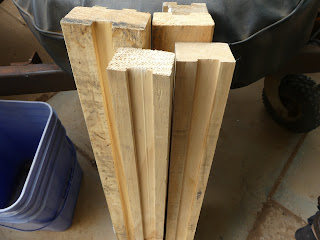A busy long-weekend rebuilding and improving the machine
A few weeks back I got the reins input working, with all the necessary transform and connection steps required. If you like, the plumbing connection has now been made. But the plumbing isn't perfect yet -- there are some knocking pipes, if you will. So I thought I would try to fix some of the more annoying issues, while it is still fresh in my mind. In particular, there can be lag of a second or more when turning.
The lag comes because I have made a simple Pulse Width Modulation scheme to implement turns of various sharpness. So for a sharp turn, it will basically try to hold the appropriate key down the whole time, while for a gentle turn, it will just stab at the key every now and then. This is based on a 1 second cycle, where some fraction of that second will be with the key down, and the remainder of the time with it released.
One of the problems of this arises when you increase or decrease the sharpness of the turn, because you have to wait for the current 1 second cycle to complete, before it will switch to the new cycle with the adjusted pulse width modulation.
There is a second problem related to this, which is if you stop turning, the horse might still keep turning for a fraction of a second. And vice versa, when you start a turn, it might be a fraction of a second before it starts the turn.
All in all, this makes it feel like you are riding a horse whose uncle was a river barge, rather than a super-obedient and well trained horse, like Unbridled effectively models.
To fix these, I need to add code that works out if you are increasing or decreasing the strength of the turn instruction -- and based on that, immediately effect the change of intention: If reducing the turn, then release the key immediately, so that it has immediate effect. Conversely, when increasing a turn, it should immediately press the key, so that the turn is sharpened without delay.
With that, it was still a bit annoying that at low turn rates that the horse's head still only ticks to the sides for brief bursts. While it makes for low turning rates, its quite annoying to use. So I have increased the minimum turning rate to 50%, which helps somewhat. I still need to implement a "centre position" sensor, so that the horse always stops turning when its facing forwards.
I was then busy for a couple of weeks, but now that Easter is here, I went to visit my dad, and took all the bits and pieces up in the trailer, and we spent the weekend working on various physical aspects of the machine. The rest of this post is a tour through that work, which followed several streams in parallel.
First up, loading the hydraulics, saddles, timber and other bits into the trailer for the 4 hour drive:
... and a pile of donated ex-mountain climbing rope that has passed its use-by date for climbing, but is still great quality rope, that I intend to use for the saddle nest, as you will see a bit later:
Okay, on arrival, the first step was to build up the vertical ends to the saddle nest. I could have paid lots of money for single slabs of wood, but instead opted for the lower-cost option of joining several smaller pieces together:
Once one end was done, it was time to start adding the cross-members for the bottom:
and some extra bracing to hold it all together, once the tension from the ropes starts loading the structure:
We used some 150mm long screws to get really solid bite between the sections:
With the other end made, and the cross-members in place, it was starting to come together:
Again, a solid piece of bracing for the other end:
Then, because the ropes will pull in from the top on each end, we added a centre brace, to stop the ends from pulling in:
Now its ready to start adding some ropes and see how the saddle sits:
That's the first two ropes, and it works okay, but we knew we would need more:
and more! What is good, is that I thought I might need some cross-ropes, but that's not necessary as it turns out. The ropes naturally conform to the shape of the saddle to a good degree, and the saddle feels quite secure on it, and can't easily rotate:
Now, while all that was going on, my dad was starting fabricating and welding up sets of concentric rings to secure the old car suspension springs that the main body at home is mounted on. First up, rolling the flat-bar we had on hand using one of my dad's old workshop tools:
While he was at the welder, I was reworking the horse head. Previously, I had it mounted on a little low table. Now I wanted to attach it to the front of the rope-based saddle nest. The head weighs about 10KG, and is close to 1m long with the neck, so it puts quite significant forces on the mount. To accommodate this, I put a big triangular wedge under a piece of 45mm thick timber:
Here is the head on the little table mount, before dismantling the lateral bearing setup:
... and a quick ride test by my daughter of the saddle nest. The verdict is that it feels like a small pony:
But it doesn't want to go for a walk. Bad mechanical horse!
More seriously, back at the rolling and welding, my dad had made considerable progress rolling up more rings. We could have used a large diameter metal pipe, but that would have been quite expensive, and quite annoying to cut into slices for the 2 lower and 2 upper spring holders:
In the meantime, I had cut-down the table panel, and drilled holes in the mounting block for the bearings, and reattached everything, so that the head and neck was now mounted directly onto the nest frame, and at a better height, although still a little low:
This still uses the very simple but effective USB mouse to read the head rotation, but is now trimmed to allow only room for that mouse, as it doesn't have to worry about the centre-of-gravity of the head being a long way forward, as the frame has enough weight to stop it toppling:With the saddle and rug back on, it's looking better already:
In the meantime, dad had started welding the rings to mounting plates. The actual mounting will be done later when I get time.
In the meantime, I had been experimenting using ropes that I could pull to tension them to tilt the saddle to simulate the horse's gait. I tried them unshrouded, and also inserted through pool noodles to reduce friction and rubbing. The noodles work well, but dampen the movement perhaps a little too much. The jury is still out on whether this "rope actuation" method will work -- but I'm going to give it a try.
Speaking of the ropes, to keep tension especially on the two upper ropes, I have used clamps to stop them slipping, and thus the ropes sinking when saddle + rider is sitting on them:
Dad in the meantime had finished working on the spring holders:
Next task was to remove the old door hinge I used to allow the head of the horse to go up and down. the weight and poor fixing position meant it was slowly warping and would die at some point. You can see here how warped it was when we removed it:
Instead, we wanted to make a super-strong hinge, that could also be easily taken apart to allow the removal of the head during transport. For this, we bought some tail-gate hinges and used some flat steel to make the hinge parts:
The exact measurements aren't important, so we just cut the pieces using a grinder:
Then it was time to weld the hinge barrels onto these plates:
One of these gets mounted between the neck rotation bearing and the block of wood, so that it can't go anywhere:
Then on the neck of the horse, I had to cut out a section to make room for the hinge barrel:
Then it was time to add screw holes and counter-sink them ready for attachment:
Putting it all together, we now have a hinge that could probably take 100KG+ of load, without warping:
Time to start putting it all back together:
And slide the head onto the hinge:
To stop the head falling off mid-ride, we use a simple locking pin:
And before we knew it, it was time to drive home in the Easter traffic, which is always an "experience" here in Australia, as lots of folks who live in the city and have limited experience driving on country highways come out in force for the long-weekend, and by the end are tired, stressed, and in many cases, a bit drunk and/or hung-over, and tend not to be particularly attentive or safe drivers. So we decided to head home first thing on the holiday Monday morning, to avoid the worst of the traffic in the afternoon. Even so, we saw plenty of poor driving, including people cutting in after overtaking us (remember we have a heavy trailer on the car, and so folks should be thinking about leaving plenty of safe stopping distance for us) just a few metres ahead while doing 110km/hour, or just sitting up our backsides with only a car-length or so between them and us. Anyway, enough whinging about traffic!
Once home, we set the machine up with Unbridled: That Horse Game again to see how it feels now that you can sit in a real saddle while controlling it with the reins:
Now that the hinge is much sturdier, it is easier to chock the head at a better angle, until I make it motorised:
So what's next?
I need to re-thread the ropes through, with more pool noodles on the main supporting ropes, partly to slightly further lift the saddle, and also to bulk out the sides of the horse a bit. I'm also considering putting panel sides on the lower part, so that there is a firm surface to register leg aids against, once I add the leg-aid sensors. Also, the neck doesn't auto-return to centre, and it doesn't know when it is exactly centred, which currently makes it a bit annoying to stop the horse turning in the game. So I'll also look at making a simple sensor for that, and improving the software to use it. It's also time to tidy up the cable runs a bit, too, so that this nest of wires aren't hanging around everywhere!
In short, thanks to lots of help from my dad, I am now at the point where I have plenty of things I can get on and do, without being held up by the hardware not being sufficient -- especially being able to work on the leg aid sensing, which I am really excited to get in place, so that you can leg-yield.
To finish up, here is a short video of the machine after we set it up again, and playing the game:





























































Comments
Post a Comment